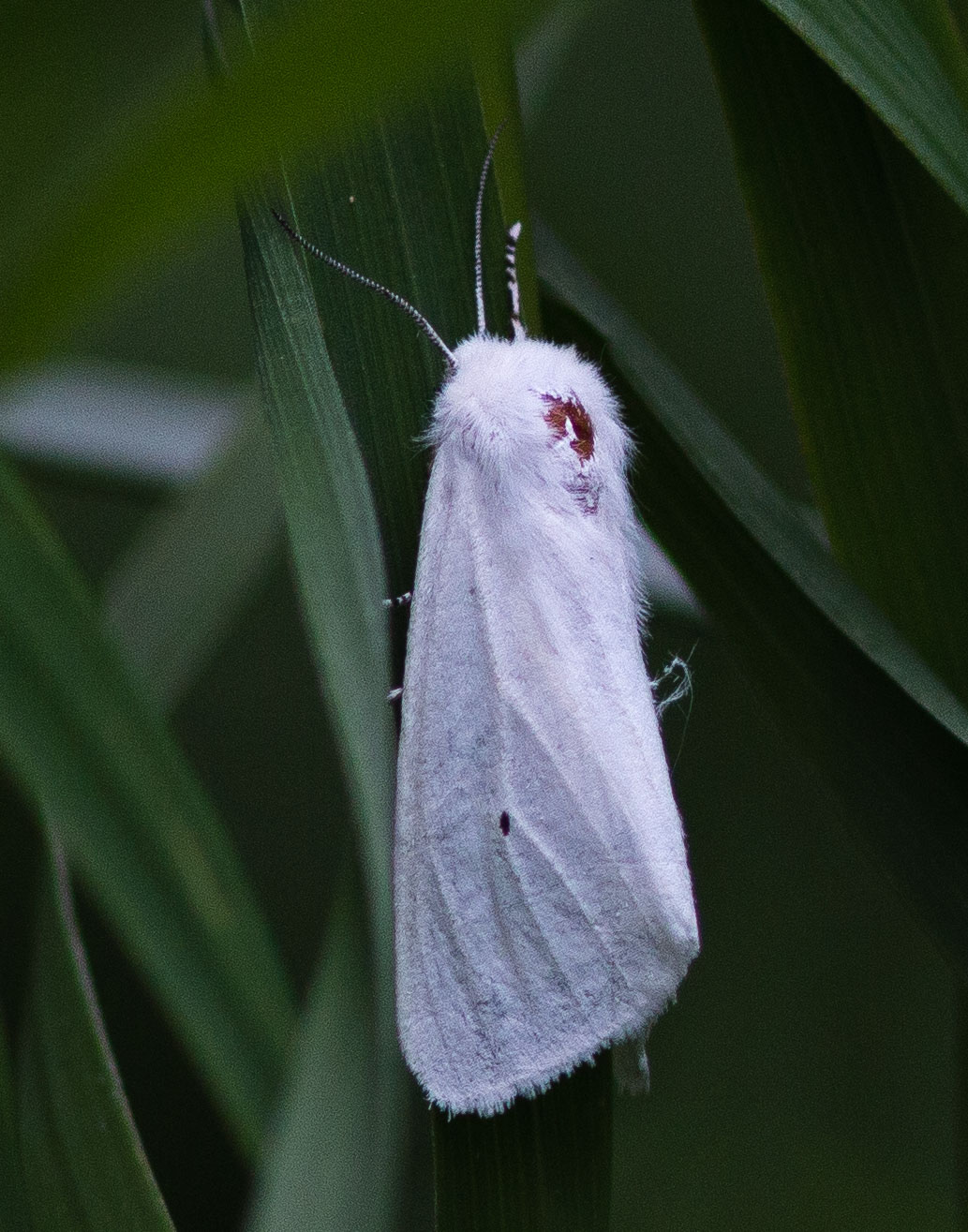
Blue Gum Farm
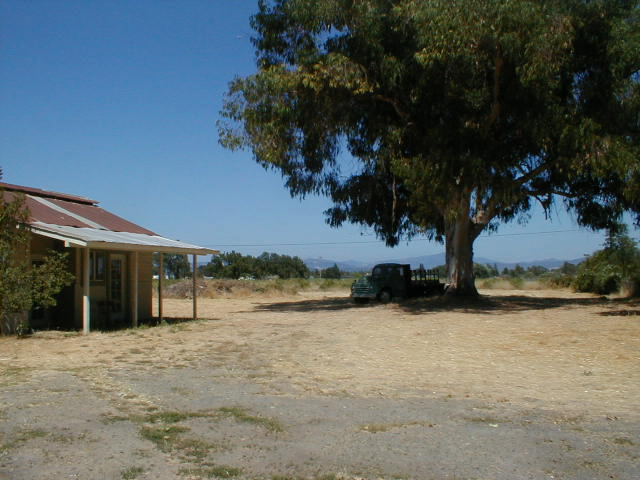 This
heritage Blue Gum Eucalyptus tree has been the home for falcons, owls,
and crows.
This
heritage Blue Gum Eucalyptus tree has been the home for falcons, owls,
and crows.
About
Blue Gum Farm
- History
- Press Room
- Renting the Gallery
- Renting a Studio
- Visiting
Archives
Art Gum Studios
Blue Gum Gallery
Calendar / Events
Featured Artist
Guest Book
Art Venues in Sonoma County
Contact
Blue Gum Farm & Gallery
P.O. Box 662
Graton, CA USA
Tel: +1 (707) 526-6887
Fax: +1 (707) 526-6889
© 2006-13
Hours by appointment only, unless during the hours posted for a specific event.
Copyright©BlueGumFarm.
All Rights Reserved.
History
Blue
Gum Farm, as it is known today, is the last four acres of what used to be
a 200 acre dairy farm started by the Browns. The big, 5,000 square foot,
two story hay barn was built in 1903, along with the a granny cottage (700
square feet!) in which the Browns lived for 40 years. In the 1920's, the
milking laws changed, and new sanitation requirements dictated the use of
cement walls where cows were milked, so another barn was built. This smaller
Milking Barn has since been divided into two artist studios, one of which
utilizes the old milk storage room as a closet!
The Browns planted several of the Blue Gum Eucalyptus trees that were so
popular as wind breaks and shade trees of the era. Those heritage trees
are now some 50-70 feet tall. One particularly fine specimen has been the
home for falcons, owls, and crows over the years. In addition to the Eucalyptus,
there are 100 year old Cottonwoods, Apples, Redwoods, Cedars, and Plum trees.
It is the Blue Gum trees that give the farm its current name. The name for
the Art Gum Studios is, of course, a cheeky art reference!
In the 1940's the Browns retired from the dairy business, and built and
moved into a larger home they built on the property, while their daughter
La'una Andrews and her son moved into the original cottage. Although the
main dairy herd was sold, a few cows and beef cattle continued to be kept,
as well as Granny Brown's beloved chickens, ducks and geese.
Over the ensuing years, Granny Brown sold off most of the acreage until
only 10 remained. Fortunately, those acres remain rural, with hay and vineyards
being the main crops. The last 10 acres were split by La'una and her second
husband into three separate properties in the 1980s, keeping the final four
acres that contained all the original buildings in the family. The Andrews
sold the property in 1999 (when La'una was a spry 87!) to Helen Gillespie,
the current owner and also a California native, who has been restoring the
property and converting it to an art enclave while honoring the rural heritage.
The Birds of Blue Gum Farm
The birds of Blue Gum Farm are a marvelous cross-section of migratory and
permanent residents.
There are several varieties of predators that include sharp-shinned falcons,
cooper's falcons, crows, turkey vultures, barn owls and a pair of great
horned owls. The residency of the cooper's hawks started in the summer of
2007 with a very hungry, very vocal juvenile that evicted some messy pigeons
from the barn, then returned in the fall with a mate and built a nest in
one of the cottonwood trees.
The property is also home to pheasants, california quail, red-winged blackbirds,
brewer's blackbirds, white-capped sparrows, chipping sparrows,western house
wrens, blue jays, western bluebirds, phoebes, towhees, black-eyed juncos,
red-headed woodpeckers, acorn woodpeckers, northern flickers, starlings,
white breasted nuthatches, bushtits, oak titmouses, robins, anna's and
rufous (red/brown) hummingbirds, mockingbirds, mourning doves, ringed turtle-doves,
house finches, and a lively flock of goldfinches -- or a "charm"
of finches as they are called. A rare yellow grosbeak was seen on June
20, 2007 and a week later on June 27 on one of the feeders in mid-afternoon
and not since ... so there's nothing like being in the right place at the
right time!
Further sightings: A very shy black-headed grosbeak was spotted picking
sunflower seeds out of the feeder on June 30, 2008, while a white-breasted
nuthatch shimmied down the post onto the feeder to see what all the excitement
was about on July 31, 2009. Neither stayed very long since a feeder is not
their typical feeding method, so they must have been either very hungry
or using a carpe diem approach!
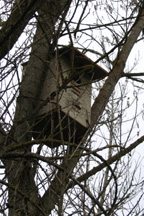
Another big treat was received on December 25, 2007 when a pair of great
horned owls stopped high in one of the Cottonwood trees around 10pm to hoot
continuously for more than an hour! They returned a month later to hoot
again but have not since returned (sigh!) - although they have been spotted
at dusk a mile down the road peering at a neighbor's field. A very large
owl box was created shortly thereafter and placed in one of the more remote
Cottonwoods to tempt them to return and stay. They have not moved in but
been seen again at dusk a mile down the road speculating about the possibilities
of dinner in a neighboring field.
Here's a wild story: On Sept 17, 2010, I had an encounter
with juvenile birds. I had shut the big barn doors after the swallows departed
early this year around Aug 26th, leaving only a side door slightly open
for the migratory bats to get in and out. Imagine my surprise when I walked
inside to hear a juvenile Cooper's Hawk screech at me! He was unhurt but
defiant and holding a starling clutched tightly in one claw. He panicked
a little and tried to fly out one of the closed windows, still clutching
his starling. He watched me closely as I used a ladder to reach and open
the highest window, then hoisted myself back down. The hawk left
his catch in a lower window and flew up to the one I just opened. I went
over to see about the starling which had tucked its head tightly into one
corner of the window. As I picked it up, it came to life and cried loudly
to be released. I carried it downstairs and outside the side door, listening
it screech the entire time. The hawk listened and waited just inside the
high window. When I got outside, I released the starling but it just flapped
to the ground; one wing injured by the hawk. I walked away and the hawk
swooped down trimphantly on the starling and carried it off.
Migratory birds include the hummingbirds; both barn and cliff swallows that
enjoy the Blue Gum barns from March through September; and, large yellow
(but very shy) Bullock's and Hooded orioles. What started as a pair of orioles
in 2003 is now a quite a large colony of some two dozen birds that return
and increase each year. The (currently) five hummingbird feeders that they
share must be filled twice daily in high summer once all the new chicks
fledge and fly. The end of the season before the hummingbirds and orioles
depart is always a treat -- what is reported by birders as a rare occurrence
of more than one hummingbird on a feeder is common on the farm -- all four
feeder holes are typically occupied by siblings with two or more birds hovering
nearby for their turn!
For their pleasure, a variety of birdhouses and bird feeders have been built
from original barn siding from the Hay Barn and are scattered throughout
the property.
Beneficial Insects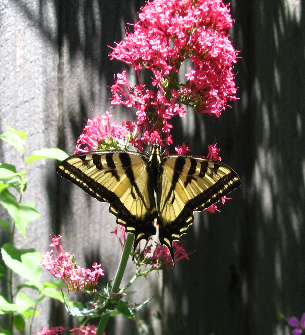
Beyond
birds, there are a number of beneficial insects, including butterflies,
moths, bees and dragonfiles. Many swallowtails (left) float around the gardens
throughout the summer as well as white cabbage butterflies.
Numerous native Bumblebees and Carpenter bees as well as Honeybees help
in the garden; the Carpenter bees inhabit the rather dated rafters in the
greenhouse roof - so that the greenhouse buzzes with their noise every night
before they settle in to sleep!
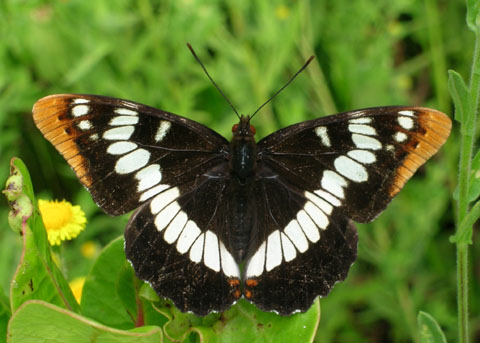 Most
recent sighting: a Lorquin's Admiral (right) was spotted on July 27, 2009
inspecting the crabapple tree.
Most
recent sighting: a Lorquin's Admiral (right) was spotted on July 27, 2009
inspecting the crabapple tree.
And now a Monarch butterfly on Aug 8, 2009 darting between the trees like
a lunatic. Apparently a 3rd generation non-migrator, so the idea of leaving
a few thistle-type weeds growing seems to have paid off!
An aging Blue-Eyed Darner or Emperor Dragonfly (not sure which; could even
have been a California Darner) was moved from the road to the fence (probably
on his last legs) on Aug 8, 2009. Very large, close to 4 inches in length,
with brilliant very large bright blue fuzziesh eyes and blue body. Handsome
specimen but looked a bit ragged.
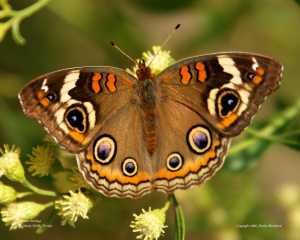 Aug
13, 2009: A California Buckeye Butterfly was sighted. Distinctive orange
slashes on the wings as well as the blue "eyes" made him easy
to identify.
Aug
13, 2009: A California Buckeye Butterfly was sighted. Distinctive orange
slashes on the wings as well as the blue "eyes" made him easy
to identify.
Lots of reportings lately, and it's not that there are more butterflies,
it's just that more effort is being taken to correctly identify them!
And then there's moths! 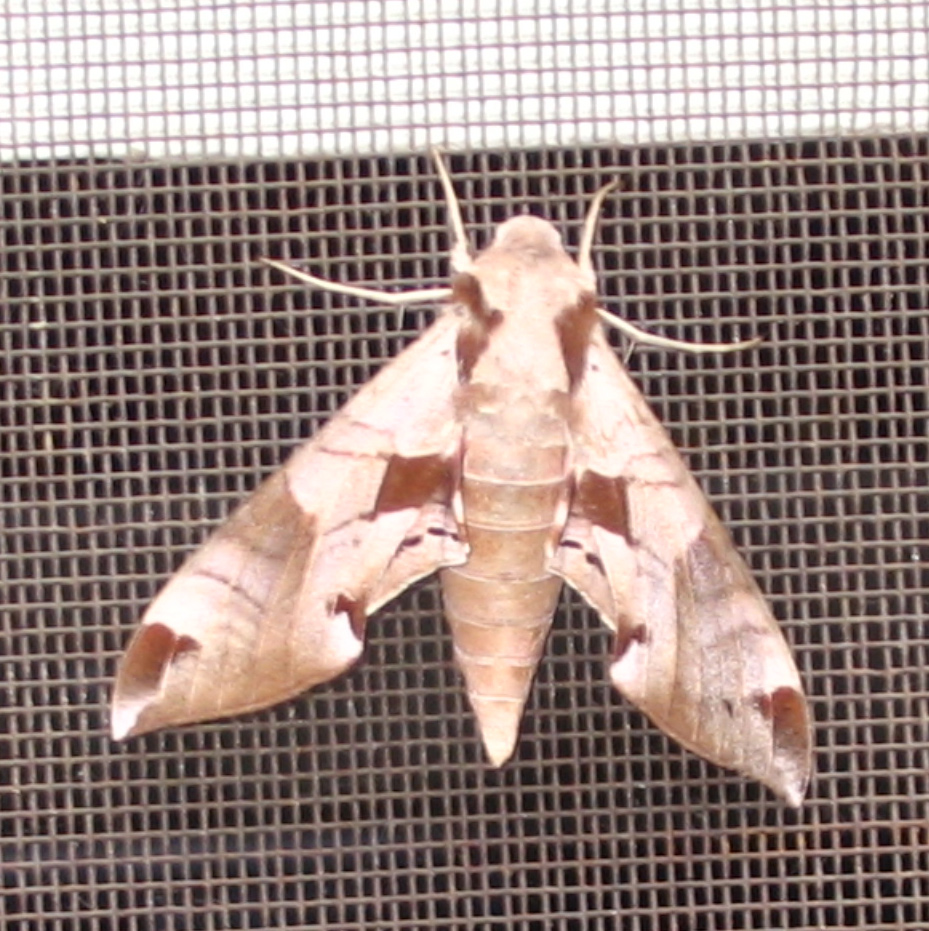 Gracie
cat brought in something huge the other night; I didn't ID it well before
putting it back outside, but it was a Sphinx, possibly a Big Poplar Sphinx,
with a 3.5-4 inch wingspan. Another one appeared the next night, Aug 24,
2009, a Pink-Spotted Hawkmoth, that decided to spend the next day attached
to a windowscreen in disguise as a leaf (see photo); if not, it is someone
else.
Gracie
cat brought in something huge the other night; I didn't ID it well before
putting it back outside, but it was a Sphinx, possibly a Big Poplar Sphinx,
with a 3.5-4 inch wingspan. Another one appeared the next night, Aug 24,
2009, a Pink-Spotted Hawkmoth, that decided to spend the next day attached
to a windowscreen in disguise as a leaf (see photo); if not, it is someone
else.
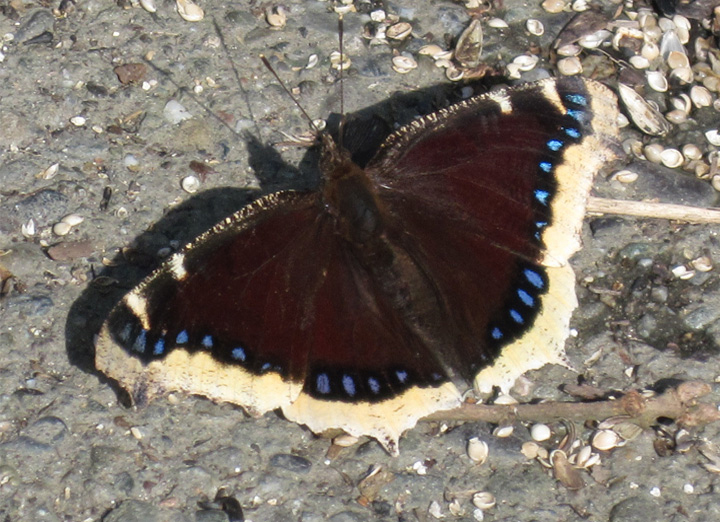 The latest visitor is a harbinger of Spring! On February 12, 2010, a dark
shape was beating against one of the barn windows, so naturally a butterfly
rescue operation was initiated for a Mourning Cloak who was still floating
around the next day, prompting further investigations and the release of
a second window prisoner.
The latest visitor is a harbinger of Spring! On February 12, 2010, a dark
shape was beating against one of the barn windows, so naturally a butterfly
rescue operation was initiated for a Mourning Cloak who was still floating
around the next day, prompting further investigations and the release of
a second window prisoner.
An interesting note: work on a new garden area has involved ripping out
quite a bit of vinca – which can be quite invasive – and revealing
numerous dormant ladybugs who have been gently moved to another area to
continue sleeping.
2010 had a long damp start that is reflected in the greater abundance of
bugs and reptiles. Constant bluebelly lizard evictions from the house ...
Mowing a patch under the cottonwoods proved to be a significant scare for
a 3 foot long king snake who quickly slithered out after I finished that
area on June 3, 2010.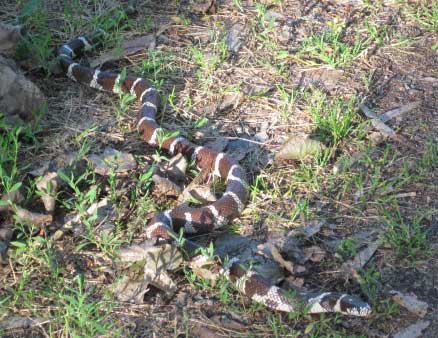
In July, the butterfly population exploded with lots of cabbage butterflies,
swallowtails, and several American Painted Ladies, one of which paused just
enough in it's frantic erratic flight to allow identification. Many more
behind the barn happily co-existing with the mallow, statis and butterfly
bushes. 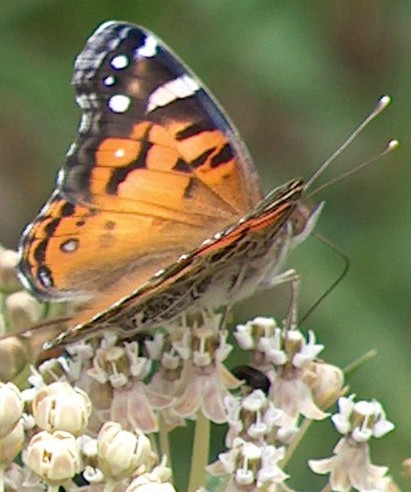
On September 5, 2010, a rather unusual small grey butterfly was seen on some clover in the back pasture near a Fiery Skipper. The grey butterfly was about an inch long with a beautiful lacy grey and white fringe around the edge of its wings. Still not able to identify it; could be a Grey Marble, or a Common Blue with summer colors or a Spring Azure... but it was definitely grey and not brown and most likely the Common Blue.
Mourning Cloaks appeared again in January in 2011. On March 25, 2011 an
unusual visitor was spotted by the barn: an Audubon's Yellow-rumped Warbler.
Just the one male that had a bright yellow cap, a bright yellow throat,
and a distinct white band across the back of the wings.
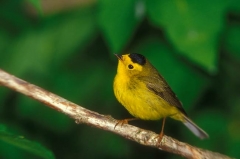 The
inclement weather in the spring of 2011 is having an odd effect: very fast
mating rituals, large numbers of hummingbirds and orioles arrived in April
then mainly disappeared with the May rain, and the goldfinch flock is much
reduced as well. There was a rufous hummingbird that stopped and took up
residence, but he may have flown further south now looking for a dryer
climate. The swallows arrived late - April 4 - but the first group of young
fledged by the end of May, and the next crop is incubating. There are still
some strange visitors to the feeders: on June 1 what looked to be a cross
between a Hermit and a Townsend's Warbler was spotted on the feeder: very
definitely a black cap, very defintely the black and white wing markings,
very definitely the yellow cheeks and breast, very definitely not a goldfinch
or a grosbeak, but perhaps it was a Wilson's Warbler cross of some kind
since those exist at the nearby Laguna.
The
inclement weather in the spring of 2011 is having an odd effect: very fast
mating rituals, large numbers of hummingbirds and orioles arrived in April
then mainly disappeared with the May rain, and the goldfinch flock is much
reduced as well. There was a rufous hummingbird that stopped and took up
residence, but he may have flown further south now looking for a dryer
climate. The swallows arrived late - April 4 - but the first group of young
fledged by the end of May, and the next crop is incubating. There are still
some strange visitors to the feeders: on June 1 what looked to be a cross
between a Hermit and a Townsend's Warbler was spotted on the feeder: very
definitely a black cap, very defintely the black and white wing markings,
very definitely the yellow cheeks and breast, very definitely not a goldfinch
or a grosbeak, but perhaps it was a Wilson's Warbler cross of some kind
since those exist at the nearby Laguna.
Saw a very interesting tiny 1-1.5 in robin's egg blue butterfly on 6/16/11.
Turns out it was a Blue Copper, Lycaena heteronea ...
On July 4, 2011 helped a fuzzy black caterpiller with orange bars across
the lane. Apparently it is a Leopard Moth caterpiller, a nocturnal black
and white moth. Cool! Also remembered that I saw a pair of very interesting
smooth green caterpillars two years ago under the cottonwoods: solid green
with just two "eyes" on their sides and I think one horn at the
back. That's a small-eyed sphinx which is definitely on-site.
A little foot long King Snake was slithering around the potted plants near the
house on 7/14/11... Spotted n American PaintedLady butterfly by the house on
7/30/11 ...
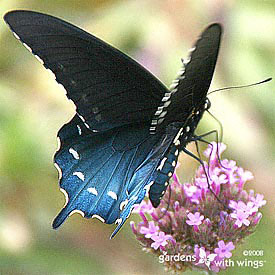 Wow! Just saw a very unusual iridescent blue butterfly. Thought it was a Mourning
Cloak till I looked at it closely and it is bigger, very dark both above and
below, almost black except the back is a deep midnight blue, particularly the
lower back wings. There is a border of small white spots. but I can't get close
enough again for a photo or better ID. It is flirting with a Swallowtail, both
of them flying high and fast, and about the same size. Today is August 10, 2013.
I think it might be a Pipevine Swallowtail (Battus philenor) but I can't confirm
the swallowtail only the colors; will run outside and chase it down again...!
Wow! Just saw a very unusual iridescent blue butterfly. Thought it was a Mourning
Cloak till I looked at it closely and it is bigger, very dark both above and
below, almost black except the back is a deep midnight blue, particularly the
lower back wings. There is a border of small white spots. but I can't get close
enough again for a photo or better ID. It is flirting with a Swallowtail, both
of them flying high and fast, and about the same size. Today is August 10, 2013.
I think it might be a Pipevine Swallowtail (Battus philenor) but I can't confirm
the swallowtail only the colors; will run outside and chase it down again...!
2015's
dry hot summer of drought seems to be having little affect on the insect
population here. Many Swallowtails, California buckeyes, cabbage
moths, and others. But I did see one that I have never seen before
on September 9 at 7:30pm just at dusk but still light. I saw a white
shape fluttering quickly in place, not the typical cabbage moth
wing action. So I went up for a closer look and found the most exquisite
white moth with very light dark spots on almost pure white wings, black
and white striped legs, and a red marking along the back of the body.
Turned out to be a Virginia Tiger Moth!
